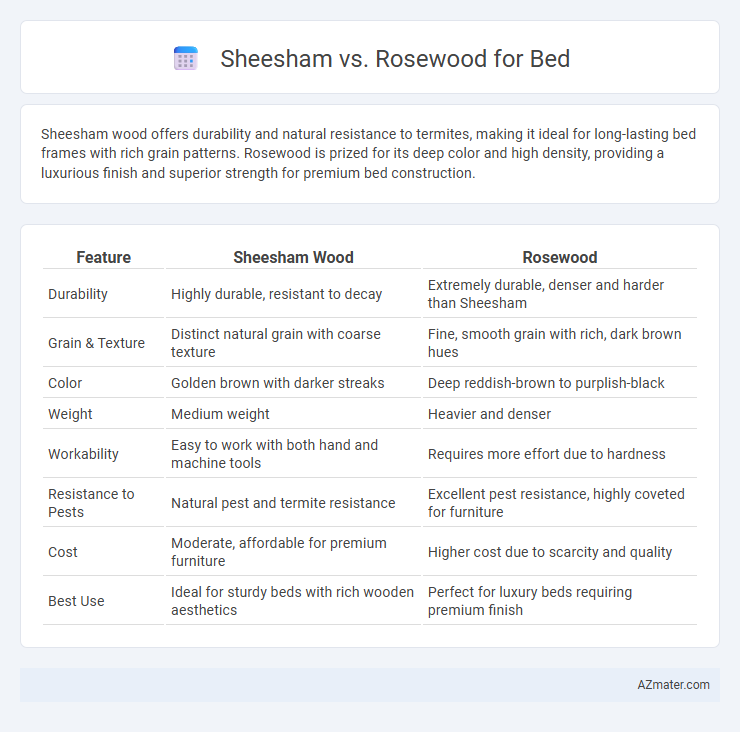Sheesham wood offers durability and natural resistance to termites, making it ideal for long-lasting bed frames with rich grain patterns. Rosewood is prized for its deep color and high density, providing a luxurious finish and superior strength for premium bed construction.
Table of Comparison
| Feature | Sheesham Wood | Rosewood |
|---|---|---|
| Durability | Highly durable, resistant to decay | Extremely durable, denser and harder than Sheesham |
| Grain & Texture | Distinct natural grain with coarse texture | Fine, smooth grain with rich, dark brown hues |
| Color | Golden brown with darker streaks | Deep reddish-brown to purplish-black |
| Weight | Medium weight | Heavier and denser |
| Workability | Easy to work with both hand and machine tools | Requires more effort due to hardness |
| Resistance to Pests | Natural pest and termite resistance | Excellent pest resistance, highly coveted for furniture |
| Cost | Moderate, affordable for premium furniture | Higher cost due to scarcity and quality |
| Best Use | Ideal for sturdy beds with rich wooden aesthetics | Perfect for luxury beds requiring premium finish |
Introduction to Sheesham and Rosewood
Sheesham, also known as Indian Rosewood, is a durable hardwood prized for its rich grain patterns and natural resistance to decay, making it a preferred choice for high-quality bed frames. Rosewood refers to several species of tropical hardwood known for their deep reddish-brown hues and dense, strong texture, offering excellent longevity and aesthetic appeal in furniture. Both woods provide robust support and elegant finishes, contributing to the functional and decorative value of beds.
Key Differences Between Sheesham and Rosewood
Sheesham and rosewood are both dense hardwoods known for durability and rich color, but Sheesham, often referred to as Indian rosewood, has a more pronounced grain pattern and warmer, reddish-brown hues compared to the darker, purplish tones of true rosewood. Rosewood is generally more expensive due to its rarity and deeper, natural oils that provide superior resistance to decay and insect damage. Sheesham offers affordability and easy maintenance while rosewood delivers premium strength and a smooth finish, making it ideal for high-end bed frames.
Appearance and Grain Patterns
Sheesham wood features rich, dark brown hues with golden or reddish streaks, showcasing pronounced, swirling grain patterns that add a natural elegance to beds. Rosewood offers a deeper, reddish-brown color palette with fine, uniform grains and occasional darker streaks, lending a luxurious and smooth texture to furniture surfaces. The distinct grain variations in Sheesham create a rustic appeal, while Rosewood's consistent texture provides a more refined and polished look ideal for high-end bedroom designs.
Durability and Strength Comparison
Sheesham and Rosewood both offer exceptional durability and strength, making them ideal choices for bed construction. Sheesham wood, known for its dense grain and natural oils, resists warping and insect damage, ensuring long-lasting structural integrity. Rosewood, prized for its hardness and high tensile strength, provides superior support and longevity in heavy-use furniture applications.
Maintenance and Care Requirements
Sheesham wood, a natural hardwood also known as Indian rosewood, requires regular oiling to maintain its rich golden-brown finish and prevent drying or cracking. Rosewood, prized for its deep reddish-brown hues and dense grain, demands careful polishing and avoidance of excessive moisture to retain its luxurious appearance and durability. Both woods benefit from gentle cleaning with a soft cloth and controlled indoor humidity to ensure lasting beauty and structural integrity in bed frames.
Price and Affordability
Sheesham wood offers a more affordable option for beds compared to Rosewood, making it popular for budget-conscious buyers seeking durability and natural grain patterns. While Rosewood is prized for its rich color and exceptional hardness, its higher price point reflects its rarity and premium status in furniture manufacturing. Choosing Sheesham for bed frames balances cost-effectiveness with attractive aesthetics, whereas Rosewood beds serve as luxury investments due to their elevated price and exclusivity.
Sustainability and Environmental Impact
Sheesham wood, also known as Indian Rosewood, offers a sustainable choice for beds due to its fast growth rate and responsible harvesting practices in well-managed plantations. Compared to traditional Rosewood species, Sheesham's lower demand reduces deforestation pressures and supports biodiversity conservation. Using Sheesham beds minimizes environmental impact while providing durable, naturally resistant furniture options.
Suitability for Bed Frames
Sheesham wood, known for its durability and rich grain patterns, offers excellent suitability for bed frames due to its strength and resistance to warping. Rosewood, prized for its luxurious appearance and natural oils, provides sturdy support but is often more expensive and less readily available for large furniture like beds. Both woods ensure longevity and aesthetic appeal, although Sheesham is preferred for cost-effective, resilient bed frames while Rosewood suits high-end, decorative designs.
Pros and Cons of Sheesham Beds
Sheesham beds offer exceptional durability and natural resistance to pests due to their dense hardwood structure, making them ideal for long-term use. The wood's rich grain patterns and warm hues provide an elegant, rustic aesthetic but it requires regular oiling to maintain its luster and prevent drying. Although Sheesham is generally more affordable than premium rosewood, it may be prone to minor surface scratches and requires careful handling to avoid damage.
Pros and Cons of Rosewood Beds
Rosewood beds are prized for their rich color, durability, and natural resistance to decay, making them a long-lasting choice for bedroom furniture. However, they tend to be heavier and more expensive compared to Sheesham, which might impact ease of movement and budget. The tight grain structure of Rosewood also requires specialized maintenance to preserve its glossy finish and prevent surface damage over time.

Infographic: Sheesham vs Rosewood for Bed
 azmater.com
azmater.com